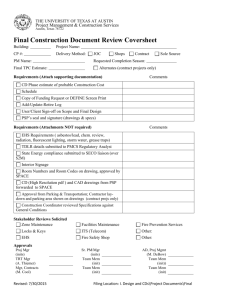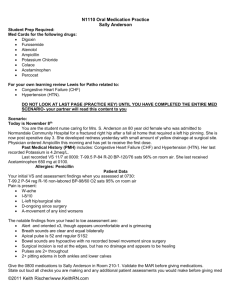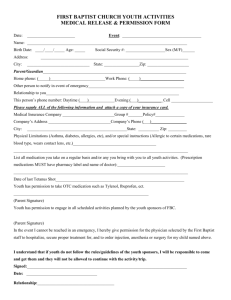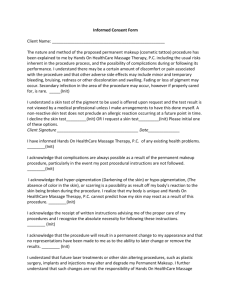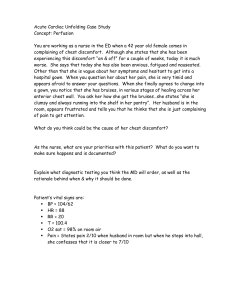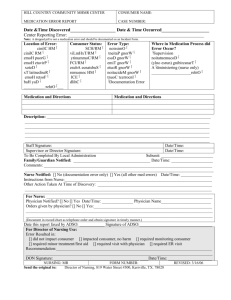N1110-SUE-JONES-Parenteral-Student-Practice
advertisement
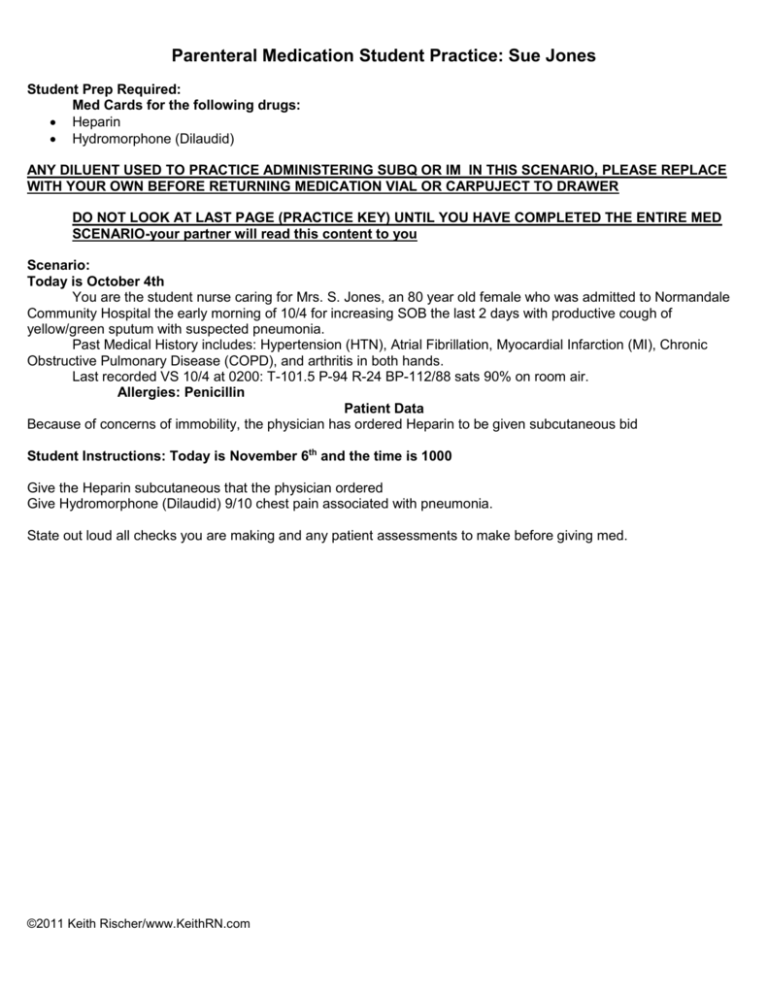
Parenteral Medication Student Practice: Sue Jones Student Prep Required: Med Cards for the following drugs: Heparin Hydromorphone (Dilaudid) ANY DILUENT USED TO PRACTICE ADMINISTERING SUBQ OR IM IN THIS SCENARIO, PLEASE REPLACE WITH YOUR OWN BEFORE RETURNING MEDICATION VIAL OR CARPUJECT TO DRAWER DO NOT LOOK AT LAST PAGE (PRACTICE KEY) UNTIL YOU HAVE COMPLETED THE ENTIRE MED SCENARIO-your partner will read this content to you Scenario: Today is October 4th You are the student nurse caring for Mrs. S. Jones, an 80 year old female who was admitted to Normandale Community Hospital the early morning of 10/4 for increasing SOB the last 2 days with productive cough of yellow/green sputum with suspected pneumonia. Past Medical History includes: Hypertension (HTN), Atrial Fibrillation, Myocardial Infarction (MI), Chronic Obstructive Pulmonary Disease (COPD), and arthritis in both hands. Last recorded VS 10/4 at 0200: T-101.5 P-94 R-24 BP-112/88 sats 90% on room air. Allergies: Penicillin Patient Data Because of concerns of immobility, the physician has ordered Heparin to be given subcutaneous bid Student Instructions: Today is November 6th and the time is 1000 Give the Heparin subcutaneous that the physician ordered Give Hydromorphone (Dilaudid) 9/10 chest pain associated with pneumonia. State out loud all checks you are making and any patient assessments to make before giving med. ©2011 Keith Rischer/www.KeithRN.com Jones, Sue Page of 2_ MR # 9355644 DOB: 04/24/1933 Room 618-2 Dr. Thompson 1 N: 2300 - 0659 D: 0700 - 1459 E: 1500 - 2259 Allergies: Penicillin STAT AND ONE TIME DOSES Date RN Init Medication/Dose/Route/Time Date/ Time Given Init Time D Time E 2000 Date: 11/6 Start Init Medication Strength Frequency route 11/6 GG Lisinopril (Zestril) 20 mg po bid 0800 11/6 GG Diltiazem (Cardizem) CD 180 mg po daily 0800 11/6 GG Warfarin (Coumadin) 50 mg po daily 11/6 GG Heparin 8000 units subcut. bid 20,000 unit/cc vial SIGNATURE INIT Gloria Gale, RN GG Date RN Init Time N SIGNATURE ©2011 Keith Rischer/www.KeithRN.com N D 0830 GG Medication/Dose/Route/Time Date: 11/7 E Date/ Time Given N D Init Date: 11/8 E N D E 0830 GG 1600 1000 2200 INIT SIGNATURE INIT SIGNATURE INIT PRNs Jones, Sue Page 2 of 2_ MR # 9355644 DOB: 04/24/1933 Room 618-2 Dr. Thompson N: 2300 - 0659 D: 0700 - 1459 E: 1500 - 2259 Allergies: Penicillin STAT AND ONE TIME DOSES Date RN Init Medication/Dose/Route/Time Medication Strength Frequency route 11/6 GG Ibuprofen (Motrin) 600 mg po every 6 hours prn for pain 11/6 GG Hydromorphone (Dilaudid) 1 mg IM every 4 hours prn severe pain INIT Gloria Gale, RN GG Init Time D Time E RN Init Date Time N SIGNATURE ©2011 Keith Rischer/www.KeithRN.com N Date: 11/7 D Date/ Time Given Medication/Dose/Route/Time Date: 11/6 Start Init SIGNATURE Date/ Time Given E N Init Date: 11/8 D E N D E 0200 GG INIT SIGNATURE INIT SIGNATURE INIT Parenteral Medication Practice Key for: Sue Jones 1. Did you calculate the correct dose of Heparin to be given? 0.4mL 2. What is the mechanism of action of Heparin and why is it given for those who are at risk for immobility? Mechanism-refer to Davis Drug-familiarize with clotting cascade-most important aspect: prevents conversion of fibrinogen to fibrin Prolongs clotting cascade making it more difficult for venous clots to form that could cause deep vein thrombosis (DVT) that could cause pulmonary embolus 3. What nursing assessments are required before giving Heparin? Assess for signs of bleeding: unusual bruising, black-tarry stools, hematuria 4. What is unique with administration of subcutaneous Heparin? Do not massage site afterwards Alternate injection sites from right to left side 5. Where is the correct location for subcutaneous administration of Heparin? Abdomen-lateral aspect above iliac crests-NOT central or close proximity to umbilicus 6. What assessments need to be made by the nurse before giving Dilaudid? Level of consciousness Orientation BP-hold if <90 Severity of pain 7. When would you reassess this patient for pain based on your knowledge of the time action profile and when this medication peaks? Peak 30-60” 8. How does Dilaudid work and what are the most common side effects? Binds to opiate receptors in CNS. Alters perception and response to painful stimuli…GENERALIZED CNS DEPRESSION Because of CNS depression>most common side effects are confusion, sedation, respiratory depression, hypotension and constipation 9. Where did you choose to administer the insulin? Why did you choose this site? What is the most you can administer in this site? 10. Where did you choose to administer the Morphine? Why did you choose this site? What is the most you can administer in this site? 11. Did you sign the MAR with your full name, SN NCC and your initials? 12. You’re all done! Good job. Good luck on the med test! ©2011 Keith Rischer/www.KeithRN.com
